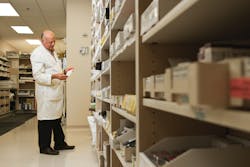Vizient forecasts increased drug spending from COVID-19 impact
Vizient, Inc. has released its Pharmacy Market Outlook, forecasting a 3.10% increase in total pharmaceutical spend for hospitals, health systems, academic medical centers and non-acute providers for Jan. 1, 2022 through Dec. 31, 2022.
While the report, an analysis of Vizient member pharmaceutical purchase data, forecasts that oncology will remain the top therapeutic class in spend by Vizient member purchases, it also projects COVID-19 to have a pronounced effect on member drug purchases. Oncology medications, which make up nearly 25% of Vizient member spend, will increase 3.25%, with numerous new molecular entities approved by the FDA. In addition, it forecasts rheumatoid arthritis drug adalimumab will continue to be ranked first in terms of spending until biosimilar competition ultimately arrives, while spending on diabetes products such as insulin will increase by 2.63%.
The Pharmacy Market Outlook also reflects on the impact COVID-19 has had on medication use spend. During the period of data analysis for this Outlook, April 2020 through March 2021, remdesivir was the third highest spend drug overall among Vizient members and the number one infectious disease related medication. Given the uncertainty of the continued progression of COVID-19 infection rates, providers must continue to devote attention to the array of infectious disease related medications.
Specialty pharmaceuticals remain a dominant force on current and anticipated drug spend. Vizient’s Pharmacy Market Outlook projects specialty pharmaceutical pricing to grow at a rate of 4.68%. This elevated growth is driven by two elements, the continued approval of highly specialized, novel drug therapies and ongoing price increases for adalimumab prior to facing biosimilar competition.
The latest Pharmacy Market Outlook is the first to include diabetes medications, which are projected to increase 2.63%. Novel diabetes drugs are gaining more indications, not only in the management of blood glucose, but also for the prevention of cardiovascular events and other disease complications. When combined with the increasing prevalence of the disease, health systems are expected to see expanded use of these products in their patient populations.
The continued expansion of indications of novel diabetes treatments and their increased use will likely result in greater expense. However, the expectation is that biosimilar competition may finally bring definitive competition to this market, another opportunity providers must continue to monitor for possible implementation.
